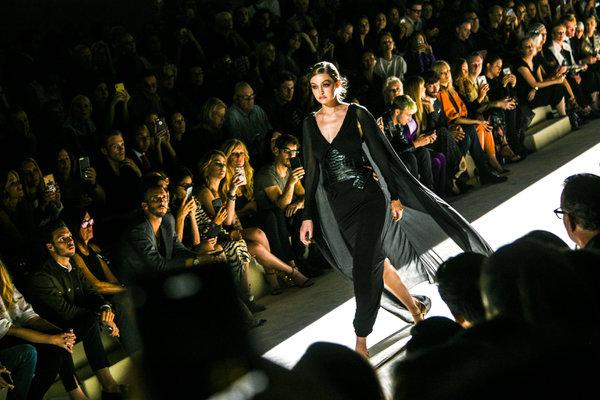Open Thread
Plus, what do people actually wear in the front row?

Gigi Hadid walks during the Tom Ford spring 2019 show on Wednesday.CreditCreditDolly Faibyshev for The New York Times
Hello and happy fashion month. Yes, after all that buildup, it is finally here.
Around this time I often get a lot of emails and tweets from people telling me they are envious or want my job. I understand where they are coming from: It is a great gig, and around show-time it looks particularly glamorous, especially from the outside.
Celebrities! Champagne! Crazy, fantastic clothes (sometimes)! What’s not to like?
The other day I saw a tweet from a co-fashion-fellow saying that fashion people should all stop calling fashion week an event to be “survived” and start acknowledging it as a privilege. That’s partly correct. But it’s also a challenge, in a whole bunch of ways.
Some of it’s physical: 14-hour days and constant deadlines. Giant shoulder bags that contain everything I need for the day and which makes me tilt to one side.
(In case you are wondering: water, notebooks, kindle, phone, pens, peanut M & Ms so I can pretend there is protein involved in my candy consumption, schedule, invitations.)
Some of it’s logistical: Today is Ralph Lauren’s 50th-anniversary black tie show and blowout, so I had to bring an extra bag to contain my quick-change black tie costume, stash it under my desk at work, and while you are reading this, I will be rushing back between shows to change in the bathroom.
(Out of which I then emerge like Supergirl in full sparkly regalia to the great amusement of my colleagues.)
Some of it’s personal: Forget bill-paying or homework-helping or kugel-grating. I’m lucky if I remember to pack my reading glasses when I leave the house in the morning.
(I forgot today.)
And some of it is professional: It can be hard to think clearly and independently amid it all, or even remember that there is a world outside where many of these clothes will eventually end up. Yet to me that’s the measuring stick by which they should be judged. At least in part.
Whether I succeed or not, you can let me know. In the meantime, I promise to try not to whine too much along the way. I’ll try to remember getting to see all this firsthand — getting to sit across the runway from Henry Golding — is, if a lot more fun than one of my early summer jobs spent in the garnishment department of the Manhattan comptroller.
And for those who are eager for more fashion week content, even if it isn’t always so pretty, spend some time with me exploring the state of modeling in the era of #TimesUp, see Ashley Graham in 3D augmented reality and read her interview about body diversity, find out why Burberry is going to be the latest fashion week brand to give up fur, and then pause for a moment to remember how Burt Reynolds changed the female gaze.
Now excuse me while I strap my heels on for Ralph’s show.
Your Style Questions, Answered
Every week on Open Thread, Vanessa will answer a reader’s fashion-related question, which you can send to her anytime via email or Twitter. This week’s question came from a call-out on Instagram. Questions are edited and condensed.
Q: What do people really wear to fashion shows? Is it actually what we see in the street-style photographs? Because I really find it hard to believe anyone wears a cocktail dress before lunch, unless it’s from the night before. — Susan, Seattle
A: Believe it! Nicki Minaj once wore pasties to a show at 10 a.m. on a Saturday. (That was in Paris.) There are two kinds of people who go to fashion shows as guests: people who go there to work, and people who go there to be seen.
Sometimes, in the case of celebrities and influencers, these two things are one and the same. (Showing up as their famous self to be seen in order to make themselves, and the designer who invited them, more famous is part of their job.) But a lot of times you can tell the two tribes apart because of what they wear.
The people who go to be seen dress for that purpose — in as eye-catching or runway-centric or seemingly absurd a way as possible. After all, the more outré or high fashion or sparkly (sequins are good for this) the outfit, the more likely it will catch the eye of one of the many photographers who haunt the entrances of shows, and then the more likely it will end up on Instagram. Even if it’s 9 a.m.
Perhaps as a reaction to this, the working people (including me) tend to dress more for practicality than as a performance piece. Editors in chief often feel the need to represent, so they will wear identifiable designer styles of the season, as if to prove you can actually wear the clothes off the runway, though they generally choose the more accessible end of the spectrum.
Otherwise sneakers have become pretty common, and not necessarily the fashion kind: Nikes are big, as are Stan Smiths. Famously, the venerated set of American Vogue contributors — Grace Coddington, Phyllis Posnick and Tonne Goodman — all had a sort of uniform of pants, white shirt, flat shoes. The theory is that during shows you aren’t supposed to be looking at them; you’re supposed to be looking at the clothes.
Vanessa Friedman is The Times’s fashion director and chief fashion critic. She was previously the fashion editor of the Financial Times. @VVFriedman
Advertisement








